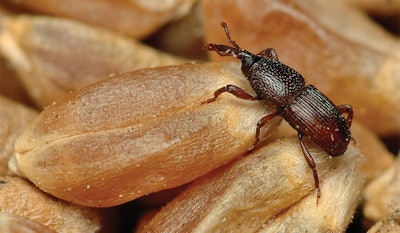
Weevils are commonly known as the most damaging insects when it comes to commodities in storage. But what makes these notorious stored grain pests so damaging and so difficult to control?
At Central Life Sciences, the Bug Free Grains Team is committed to keeping stored grain protected from insect infestations, including the devastating damage delivered by weevils. That means providing the information producers need to protect grain, and offering a range of product solutions, including two innovative tools in the arsenal that are particularly effective for weevil control, Gravista™ Insecticide and Centynal™ Synergized Insecticide.
The Particular Damage Weevils Cause
The damage weevils cause to stored grain can be summed up in one phrase: “from the inside out.” The reason it’s often difficult to diagnose a weevil problem before it’s too late is because weevil larvae grow inside sealed kernels and eat their way from the inside out as they grow, creating a “shot hole” appearance in grain kernels.
The adult weevil bores a small hole into the surface of the grain kernel, lays an egg, then covers the egg with a gelatinous fluid. This process makes control of immature weevils very difficult. The immature weevils consume the kernel interior and within approximately 4 weeks, grow into an adult weevil in the kernel interior. When the adult weevil emerges from the kernel interior, a hollow kernel remains. An adult weevil’s lifespan ranges from 7-8 months, and females can lay between 50 to 250 eggs.
Common Weevil Species
The weevils found in North America are typically rice weevils, granary weevils, or maize weevils. Let’s take a look at some of the distinctions and similarities of each:
- Rice Weevils, or Sitophilus oryzae, are strong fliers and internal feeders that possess four light-red-to-yellow markings on their forewings and have a densely-pitted thorax. Infesting stored grains as primary feeders, rice weevil infestations typically start in the field. In storage, the weevil can easily move throughout the storage facility destroying whole grain, with a minimum life cycle of 28 days.
- Granary Weevils, or Sitophilus granarius, are typically smaller than the rice weevil. Adult granary weevils do not have wings or markings on forewings. Since these weevils do not fly, infestations are linked to localized infestations at the storage site and infested grain transportation systems, underscoring the need to treat trucks and equipment for insects. They also have a minimum life cycle of 28 days.
- Maize weevils, or Sitophilus zeamais, are known throughout the U.S. as “the greater rice weevil.” Maize weevils attack both standing crops and stored grain, including corn, wheat, rice, sorghum, oats, barley, rye, and buckwheat. Their coloring varies from dull red-brown to almost black and they are usually marked on the back with light reddish or yellowish spots, with a minimum life cycle of 28 days.
Prevention & Control
In order to prevent weevil infestations, regularly cleaning and treating all storage facilities and bins as part of a S.L.A.M. program is best practice.
Implementing a S.L.A.M. (Sanitation, Loading, Aeration and Monitoring) program is a must for prevention of weevils and other stored grain insects. Performing regular temperature checks as part of the process is also important, as heat at the grain surface is a common indicator of a weevil problem.
When it comes to treatment options to prevent against and/or treat a weevil infestation, Central Life Sciences has you covered:
- Central Life Sciences has recently introduced Gravista™ Insecticide to the market. Featuring 3-in-1 insect control with an adulticide, an insect growth regulator (IGR) and a synergist, Gravista™ Insecticide kills labeled insects and breaks their life cycles without the need to tank mix.
- Centynal™ Synergized Insecticide brings a boost to short-term grain storage and rescue treatments by combining both an adulticide and a synergist.
Both Gravista™ Insecticide and Centynal™ Synergized Insecticide are designed to control even the toughest weevil infestations.
From insect growth regulators, insecticides, synergists, and combination products, the versatile Bug Free Grains lineup from Central Life Sciences is available in liquid and dry formats to help control stored product insects including the elusive weevil, to help keep your stored grain protected from the profit-robbing damage weevils cause.
Maintaining a strong sanitation program along with using grain protectant products can help control post-harvest weevil damage. Central Life Sciences has solutions perfectly suited to any grain treatment situation.
For more information on protecting your grain against weevils, visit bugfreegrains.com.
Gravista and Centynal are trademarks of Wellmark International.
